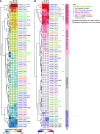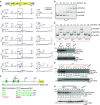CRP-Like Transcriptional Regulator MrpC Curbs c-di-GMP and 3',3'-cGAMP Nucleotide Levels during Development in Myxococcus xanthus
- PMID: 35164555
- PMCID: PMC8844925
- DOI: 10.1128/mbio.00044-22
CRP-Like Transcriptional Regulator MrpC Curbs c-di-GMP and 3',3'-cGAMP Nucleotide Levels during Development in Myxococcus xanthus
Abstract
Myxococcus xanthus has a nutrient-regulated biphasic life cycle forming predatory swarms in the presence of nutrients and spore-filled fruiting bodies in the absence of nutrients. The second messenger 3'-5', 3'-5 cyclic di-GMP (c-di-GMP) is essential during both stages of the life cycle; however, different enzymes involved in c-di-GMP synthesis and degradation as well as several c-di-GMP receptors are important during distinct life cycle stages. To address this stage specificity, we determined transcript levels using transcriptome sequencing (RNA-seq) and transcription start sites using Cappable sequencing (Cappable-seq) during growth and development genome wide. All 70 genes encoding c-di-GMP-associated proteins were expressed, with 28 upregulated and 10 downregulated during development. Specifically, the three genes encoding enzymatically active proteins with a stage-specific function were expressed stage specifically. By combining operon mapping with published chromatin immunoprecipitation sequencing (ChIP-seq) data for MrpC (M. Robinson, B. Son, D. Kroos, L. Kroos, BMC Genomics 15:1123, 2014, http://dx.doi.org/10.1186/1471-2164-15-1123), the cAMP receptor protein (CRP)-like master regulator of development, we identified nine developmentally regulated genes as regulated by MrpC. In particular, MrpC directly represses the expression of dmxB, which encodes the diguanylate cyclase DmxB that is essential for development and responsible for the c-di-GMP increase during development. Moreover, MrpC directly activates the transcription of pmxA, which encodes a bifunctional phosphodiesterase that degrades c-di-GMP and 3',3'-cGAMP in vitro and is essential for development. Thereby, MrpC regulates and curbs the cellular pools of c-di-GMP and 3',3'-cGAMP during development. We conclude that temporal regulation of the synthesis of proteins involved in c-di-GMP metabolism contributes to c-di-GMP signaling specificity. MrpC is important for this regulation, thereby being a key regulator of developmental cyclic di-nucleotide metabolism in M. xanthus. IMPORTANCE The second messenger c-di-GMP is important during both stages of the nutrient-regulated biphasic life cycle of Myxococcus xanthus with the formation of predatory swarms in the presence of nutrients and spore-filled fruiting bodies in the absence of nutrients. However, different enzymes involved in c-di-GMP synthesis and degradation are important during distinct life cycle stages. Here, we show that the three genes encoding enzymatically active proteins with a stage-specific function are expressed stage specifically. Moreover, we find that the master transcriptional regulator of development MrpC directly regulates the expression of dmxB, which encodes the diguanylate cyclase DmxB that is essential for development, and of pmxA, which encodes a bifunctional phosphodiesterase that degrades c-di-GMP and 3',3'-cGAMP in vitro and is essential for development. We conclude that temporal regulation of the synthesis of proteins involved in c-di-GMP metabolism contributes to c-di-GMP signaling specificity and that MrpC plays an important role in this regulation.
Keywords: 3'; 3'-cGAMP; CRP; CRP-like proteins; Cappable-seq; PilZ; c-di-GMP; cGAMP; cyclic nucleotides; development; diguanylate cyclase; fruiting body formation; phosphodiesterase; second messenger; sporulation.
Conflict of interest statement
The authors declare no conflict of interest.
Figures







Similar articles
-
A Minimal Threshold of c-di-GMP Is Essential for Fruiting Body Formation and Sporulation in Myxococcus xanthus.PLoS Genet. 2016 May 23;12(5):e1006080. doi: 10.1371/journal.pgen.1006080. eCollection 2016 May. PLoS Genet. 2016. PMID: 27214040 Free PMC article.
-
Cyclic Di-GMP Regulates Type IV Pilus-Dependent Motility in Myxococcus xanthus.J Bacteriol. 2015 Jun 29;198(1):77-90. doi: 10.1128/JB.00281-15. Print 2016 Jan 1. J Bacteriol. 2015. PMID: 26124238 Free PMC article.
-
Three PilZ Domain Proteins, PlpA, PixA, and PixB, Have Distinct Functions in Regulation of Motility and Development in Myxococcus xanthus.J Bacteriol. 2021 Jun 8;203(13):e0012621. doi: 10.1128/JB.00126-21. Epub 2021 Jun 8. J Bacteriol. 2021. PMID: 33875546 Free PMC article.
-
Dual regulation with Ser/Thr kinase cascade and a His/Asp TCS in Myxococcus xanthus.Adv Exp Med Biol. 2008;631:111-21. doi: 10.1007/978-0-387-78885-2_7. Adv Exp Med Biol. 2008. PMID: 18792684 Review.
-
[Activity of cyclic diguanylate (c-di-GMP) in bacteria and the study of its derivatives].Yao Xue Xue Bao. 2012 Mar;47(3):307-12. Yao Xue Xue Bao. 2012. PMID: 22645753 Review. Chinese.
Cited by
-
Combinatorial control of type IVa pili formation by the four polarized regulators MglA, SgmX, FrzS, and SopA.J Bacteriol. 2024 Nov 21;206(11):e0010824. doi: 10.1128/jb.00108-24. Epub 2024 Oct 15. J Bacteriol. 2024. PMID: 39404445 Free PMC article.
-
Functional Degeneracy in Paracoccus denitrificans Pd1222 Is Coordinated via RamB, Which Links Expression of the Glyoxylate Cycle to Activity of the Ethylmalonyl-CoA Pathway.Appl Environ Microbiol. 2023 Jul 26;89(7):e0023823. doi: 10.1128/aem.00238-23. Epub 2023 Jun 15. Appl Environ Microbiol. 2023. PMID: 37318336 Free PMC article.
-
Transcriptomic analysis of Myxococcus xanthus csgA, fruA, and mrpC mutants reveals extensive and diverse roles of key regulators in the multicellular developmental process.BMC Genomics. 2025 Apr 8;26(1):355. doi: 10.1186/s12864-025-11417-z. BMC Genomics. 2025. PMID: 40200151 Free PMC article.
-
Curare and GenExVis: a versatile toolkit for analyzing and visualizing RNA-Seq data.BMC Bioinformatics. 2024 Mar 29;25(1):138. doi: 10.1186/s12859-024-05761-2. BMC Bioinformatics. 2024. PMID: 38553675 Free PMC article.
-
Evolution of cyclic di-GMP signalling on a short and long term time scale.Microbiology (Reading). 2023 Jun;169(6):001354. doi: 10.1099/mic.0.001354. Microbiology (Reading). 2023. PMID: 37384391 Free PMC article.
References
MeSH terms
Substances
LinkOut - more resources
Full Text Sources
Research Materials
Miscellaneous
